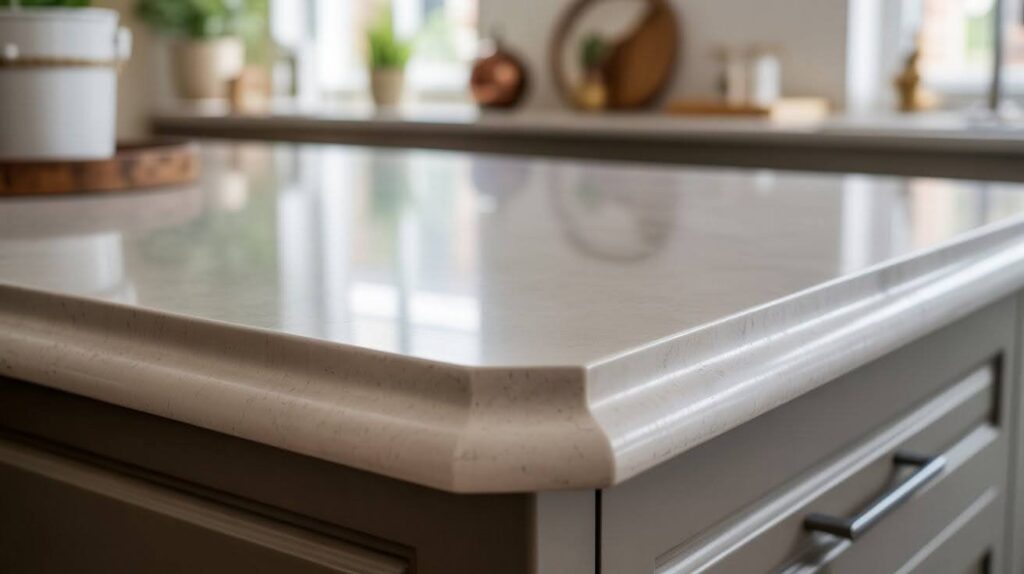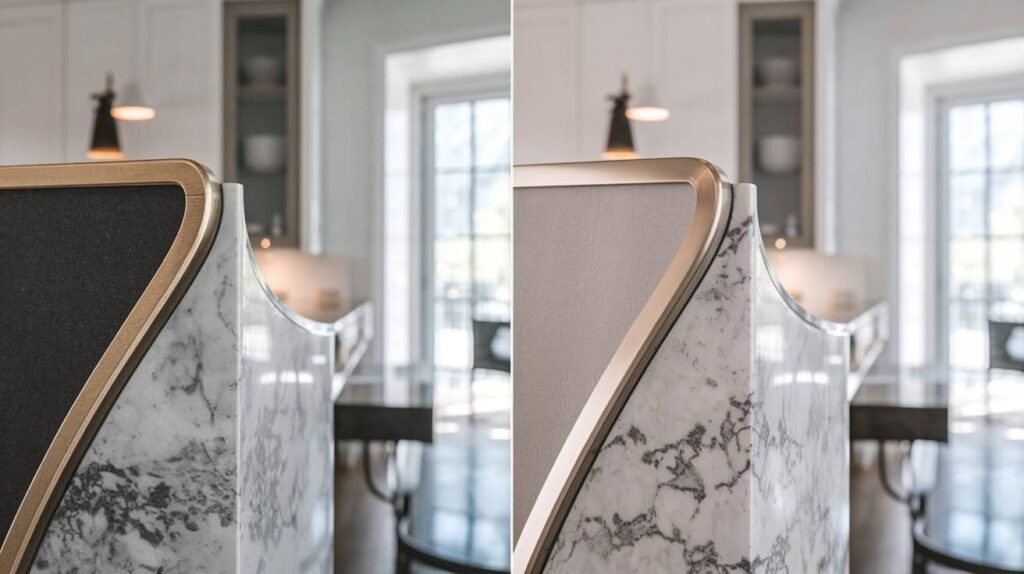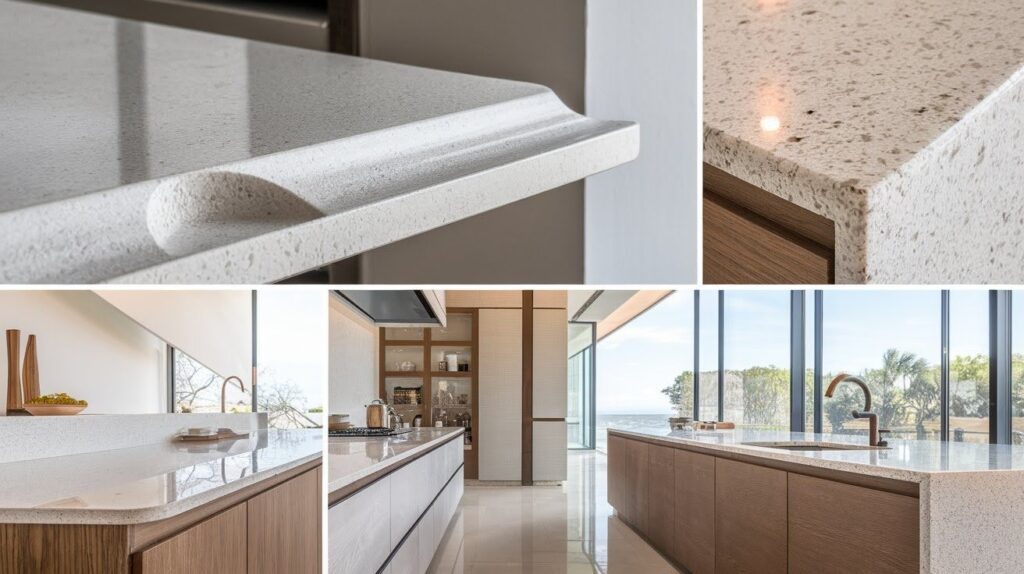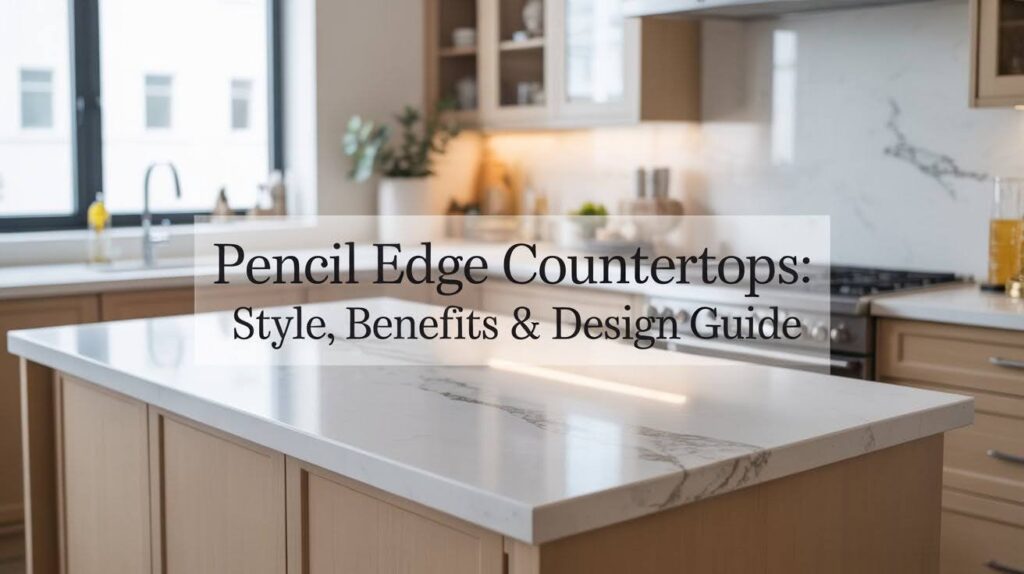When I first started planning my kitchen remodel, I didn’t realize how much the countertop edge would matter. But trust me, it does.
Pencil edge countertops caught my attention because they’re practical and good-looking without trying too hard.
The edges have a soft, rounded curve like a pencil, which feels safe around kids and looks clean in any kitchen style.
If you’re standing where I was, trying to pick the right countertop, you’ll want to know what makes this option different.
Let me share what I’ve learned about pencil edge countertops and why they might work for you.
What Is a Pencil Edge Countertop?

A pencil edge countertop features a gently rounded top edge that softens sharp corners while fitting both modern and traditional kitchen styles.
Definition and Design Overview
A pencil edge has a soft, rounded curve along the top of your countertop. It’s named after the rounded tip of a pencil.
This gentle curve replaces harsh 90-degree angles. The result is a smoother, more finished look that’s easier on the eyes and safer for families.
Pencil edges fit any kitchen style. They look great in modern spaces and traditional homes alike. The simple profile adds polish without being showy.
How Pencil Edge Countertops Are Made
Fabricators create pencil edges using specialized grinding tools. They start with a flat slab and carefully shape the top edge into a rounded curve.
The process involves marking, grinding, and polishing. Each step requires precision to get that smooth, consistent curve.
Most countertop materials work with pencil edging. Granite and quartz are popular choices for durability. Marble offers a luxury look. Even laminate can have a pencil edge, making this style budget-friendly.
Key Characteristics of Pencil Edge Countertops

Pencil edge countertops combine clean lines with practical benefits, making them a smart choice for any room in your home.
Appearance and Shape
The pencil edge has a sleek, rounded profile. It’s subtle and refined without being decorative.
The curve flows smoothly from the countertop surface. No harsh angles or abrupt lines. Just a clean, polished finish.
Design Versatility
Pencil edges work with any style. They fit minimalist kitchens, transitional spaces, and traditional homes equally well.
You can use them anywhere. Kitchens, bathroom vanities, bar tops, and islands all look great with pencil edges. The simple design fits any space that needs countertop surfaces.
Durability and Safety Features
Rounded edges last longer than sharp corners. They resist chipping when you bump them with cookware or appliances.
They’re safer too. Families with kids appreciate edges that won’t cause injuries from accidental bumps. The smooth curve is much gentler than a sharp 90-degree angle.
Types of Pencil Edge Countertops
Pencil edges come in several variations, each offering a slightly different look to match your style preferences.
1. Standard Pencil Edge

The standard pencil edge features a single, gentle curve along the top. It’s the most common option you’ll see.
This style keeps things simple and clean. The uniform curve looks refined without calling attention to itself. It’s perfect for homeowners who want a finished look that doesn’t compete with other kitchen elements.
2. Double Pencil Edge

A double pencil edge has rounded curves on both the top and bottom of the countertop edge. This creates a thicker, more substantial appearance.
The extra curve gives your countertops more visual weight. This style works well in traditional kitchens or spaces where you want countertops to feel more prominent. The doubled curves create a fuller, more finished edge profile.
3. Extended and Beveled Pencil Edges

The extended pencil edge has a larger, more pronounced curve. It softens the countertop edge even more than the standard version.
A beveled pencil edge combines a rounded curve with a slight angle. The angle adds depth and creates subtle shadows along the edge. This variation gives you extra visual interest while keeping the overall profile relatively simple.
Both options work well if you want something slightly different from the standard pencil edge but still want to keep things understated.
Benefits of Choosing a Pencil Edge Countertop
Pencil edge countertops offer practical advantages that go beyond good looks, making them a popular choice for homeowners.
- Timeless look that never goes out of style: Pencil edges work in both contemporary and classic kitchens. The simple profile stays relevant no matter how design trends shift.
- Cleaning is quick and easy: The smooth, rounded edge has no grooves or crevices where dirt and grime can hide. You can wipe down the edge in seconds without food particles getting trapped.
- More affordable than fancier edge styles: Fabricators can create pencil edges faster than complex profiles like ogee or waterfall edges. Less labor time means lower costs and a polished look without the premium price.
- Safer for families with children: Rounded corners won’t cause serious injuries if someone bumps into them. The curve offers protection at countertop height where kids might accidentally hit their heads.
- Lasts longer than sharp-edged countertops: Sharp corners chip and crack easily from daily wear and tear. The rounded profile distributes impact force better, keeping your countertops looking good for years.
Comparing Pencil Edge to Other Countertop Edges

Understanding how pencil edges compare to other styles helps you choose the right profile for your space.
Pencil Edge vs. Eased Edge
Pencil edges have a more noticeable rounded curve. The shape is softer and more defined, giving your countertops a polished, modern appearance.
Eased edges are more subtle. They just barely round off the sharp corner, creating an almost flat profile. This works best for strict minimalist designs where you want the countertop to feel nearly invisible.
Pencil Edge vs. Bullnose and Beveled
Bullnose edges curve completely from top to bottom in a half-circle shape. This creates a fuller, more traditional look that adds significant visual weight to your countertops.
Beveled edges use angles instead of curves. The top edge is cut at a slant, creating geometric lines and crisp shadows. This gives you a contemporary, architectural feel that’s more angular than the soft pencil edge.
Pencil edges sit somewhere in the middle. They’re more defined than eased edges but less dramatic than bullnose. They’re softer than beveled edges but still maintain clean lines.
Conclusion
After years of helping homeowners choose the right countertops, I’ve seen pencil edges prove their worth time and again.
They’re one of those rare design choices that just works, no matter what style you prefer or how your tastes change over time.
What I love most is how they balance form and function. You get a finished, professional look without spending extra on complicated edge work.
Your family stays safer with those rounded corners. Cleaning takes half the time. And best of all, you won’t look at your kitchen in five years and wish you’d chosen something different.
Pencil edges are simple, practical, and they look good. Sometimes that’s exactly what your home needs.
Frequently Asked Questions
What is a pencil edge countertop?
A pencil edge countertop has a gently rounded curve along the top edge, similar to the shape of a pencil tip. This simple profile softens sharp corners while maintaining a clean, finished look.
Are pencil edge countertops expensive?
Pencil edges are one of the most budget-friendly edge profiles available. They require less fabrication time than complex edges, which helps keep your overall countertop costs down.
Can pencil edges work with any countertop material?
Yes, pencil edges work with granite, quartz, marble, and even laminate countertops. Most solid surface materials can be shaped into this profile, giving you plenty of material options.
How do I clean a pencil edge countertop?
Simply wipe the edge with a damp cloth and your regular countertop cleaner. The smooth, rounded surface has no grooves or corners where dirt can collect, making maintenance fast and easy.
Are pencil edge countertops safe for kids?
Yes, the rounded edge is much safer than sharp 90-degree corners. If someone accidentally bumps into the counter, the curve reduces the risk of injury compared to pointed edges.

